2001 BMW 325XI turn signal
[x] Cancel search: turn signalPage 10 of 211
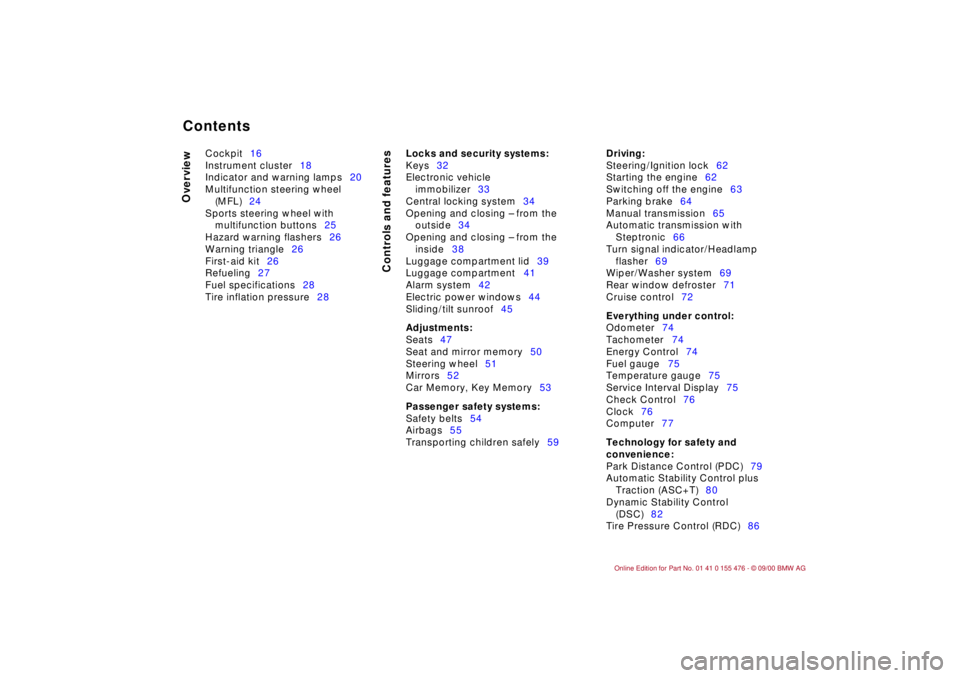
Contents
Overview
Controls and features
Cockpit16
Instrument cluster18
Indicator and warning lamps20
Multifunction steering wheel
(MFL)24
Sports steering wheel with
multifunction buttons25
Hazard warning flashers26
Warning triangle26
First-aid kit26
Refueling27
Fuel specifications28
Tire inflation pressure28
Locks and security systems:
Keys32
Electronic vehicle
immobilizer33
Central locking system34
Opening and closing Ð from the
outside34
Opening and closing Ð from the
inside38
Luggage compartment lid39
Luggage compartment41
Alarm system42
Electric power windows44
Sliding/tilt sunroof45
Adjustments:
Seats47
Seat and mirror memory50
Steering wheel51
Mirrors52
Car Memory, Key Memory53
Passenger safety systems:
Safety belts54
Airbags55
Transporting children safely59
Driving:
Steering/Ignition lock62
Starting the engine62
Switching off the engine63
Parking brake64
Manual transmission65
Automatic transmission with
Steptronic66
Turn signal indicator/Headlamp
flasher69
Wiper/Washer system69
Rear window defroster71
Cruise control72
Everything under control:
Odometer74
Tachometer74
Energy Control74
Fuel gauge75
Temperature gauge75
Service Interval Display75
Check Control76
Clock76
Computer77
Technology for safety and
convenience:
Park Distance Control (PDC)79
Automatic Stability Control plus
Traction (ASC+T)80
Dynamic Stability Control
(DSC)82
Tire Pressure Control (RDC)86
Contents
Page 17 of 211
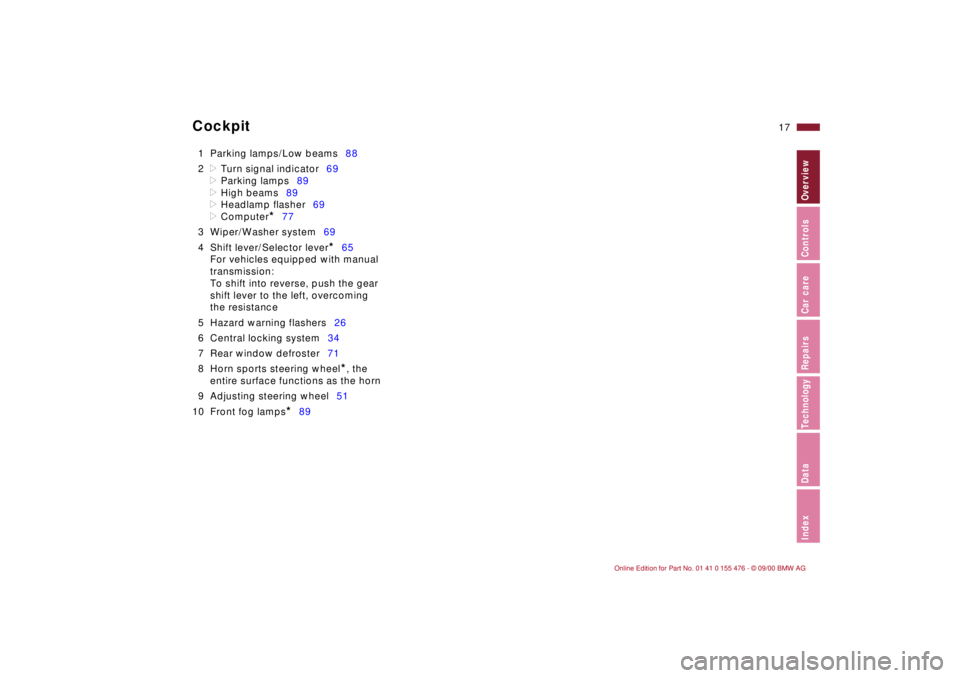
17n
IndexDataTechnologyRepairsCar careControlsOverview
Cockpit
1 Parking lamps/Low beams88
2
>
Turn signal indicator69
>
Parking lamps89
>
High beams89
>
Headlamp flasher69
>
Computer
*
77
3 Wiper/Washer system69
4 Shift lever/Selector lever
*
65
For vehicles equipped with manual
transmission:
To shift into reverse, push the gear
shift lever to the left, overcoming
the resistance
5 Hazard warning flashers26
6 Central locking system34
7 Rear window defroster71
8 Horn sports steering wheel
*
, the
entire surface functions as the horn
9 Adjusting steering wheel51
10 Front fog lamps
*
89
Page 19 of 211
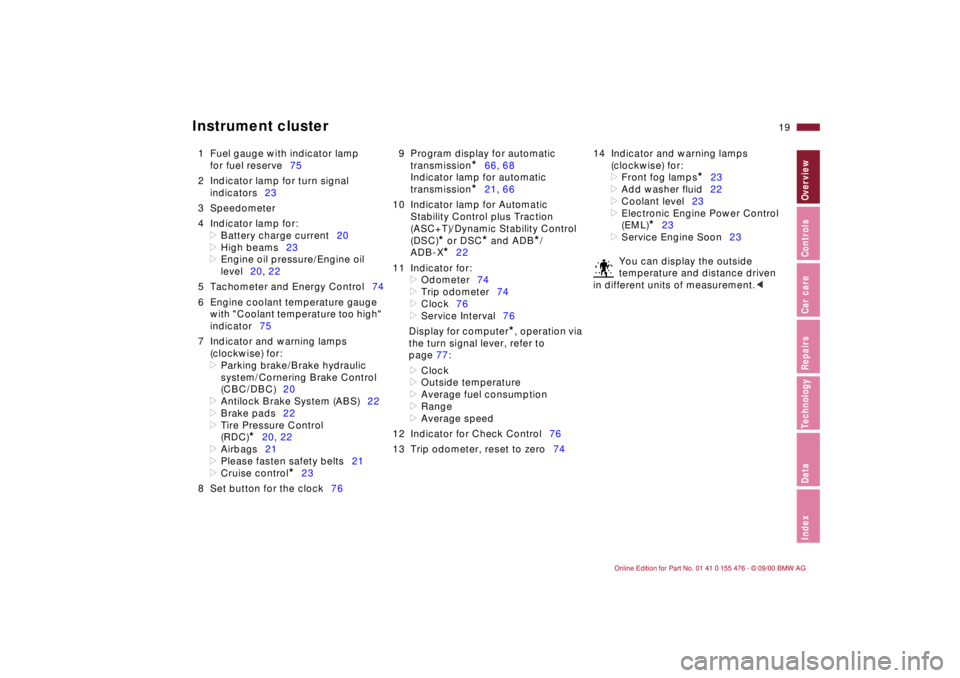
19n
IndexDataTechnologyRepairsCar careControlsOverview
Instrument cluster
1 Fuel gauge with indicator lamp
for fuel reserve75
2 Indicator lamp for turn signal
indicators23
3 Speedometer
4 Indicator lamp for:
>
Battery charge current20
>
High beams23
>
Engine oil pressure/Engine oil
level20, 22
5 Tachometer and Energy Control74
6 Engine coolant temperature gauge
with "Coolant temperature too high"
indicator75
7 Indicator and warning lamps
(clockwise) for:
>
Parking brake/Brake hydraulic
system/Cornering Brake Control
(CBC/DBC)20
>
Antilock Brake System (ABS)22
>
Brake pads22
>
Tire Pressure Control
(RDC)
*
20, 22
>
Airbags21
>
Please fasten safety belts21
>
Cruise control
*
23
8 Set button for the clock769 Program display for automatic
transmission
*
66, 68
Indicator lamp for automatic
transmission
*
21, 66
10 Indicator lamp for Automatic
Stability Control plus Traction
(ASC+T)/Dynamic Stability Control
(DSC)
*
or DSC
*
and ADB
*
/
ADB-X
*
22
11 Indicator for:
>
Odometer74
>
Trip odometer74
>
Clock76
>
Service Interval76
Display for computer
*
, operation via
the turn signal lever, refer to
page 77:
>
Clock
>
Outside temperature
>
Average fuel consumption
>
Range
>
Average speed
12 Indicator for Check Control76
13 Trip odometer, reset to zero7414 Indicator and warning lamps
(clockwise) for:
>
Front fog lamps
*
23
>
Add washer fluid22
>
Coolant level23
>
Electronic Engine Power Control
(EML)
*
23
>
Service Engine Soon23
You can display the outside
temperature and distance driven
in different units of measurement.
<
Page 20 of 211
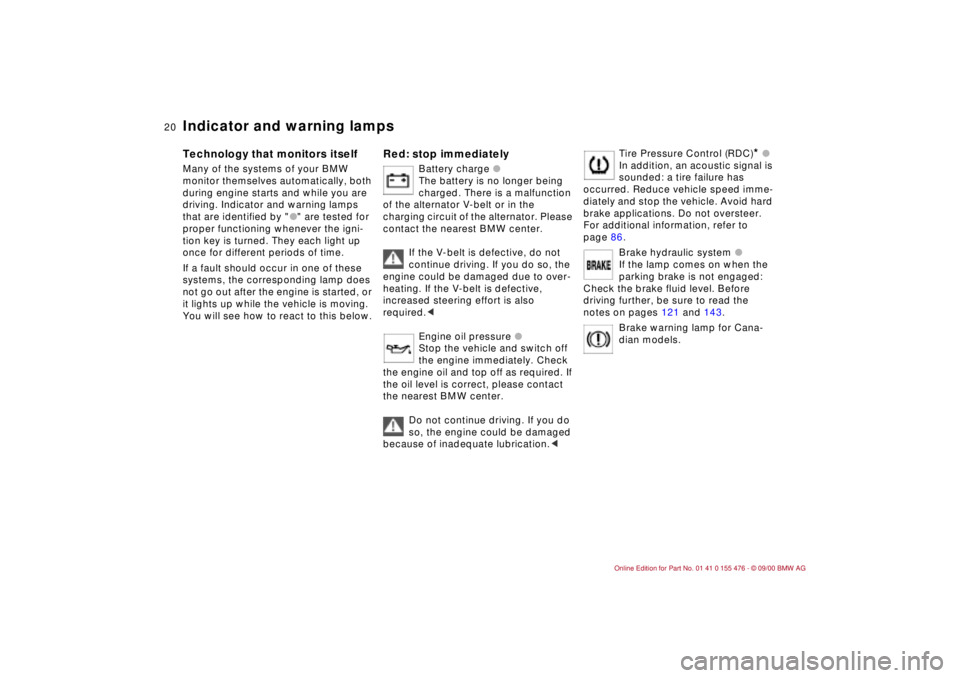
20n
Indicator and warning lamps Technology that monitors itself Many of the systems of your BMW
monitor themselves automatically, both
during engine starts and while you are
driving. Indicator and warning lamps
that are identified by "l" are tested for
proper functioning whenever the igni-
tion key is turned. They each light up
once for different periods of time.
If a fault should occur in one of these
systems, the corresponding lamp does
not go out after the engine is started, or
it lights up while the vehicle is moving.
You will see how to react to this below.
Red: stop immediately
Battery charge l
The battery is no longer being
charged. There is a malfunction
of the alternator V-belt or in the
charging circuit of the alternator. Please
contact the nearest BMW center.
If the V-belt is defective, do not
continue driving. If you do so, the
engine could be damaged due to over-
heating. If the V-belt is defective,
increased steering effort is also
required.<
Engine oil pressure
l
Stop the vehicle and switch off
the engine immediately. Check
the engine oil and top off as required. If
the oil level is correct, please contact
the nearest BMW center.
Do not continue driving. If you do
so, the engine could be damaged
because of inadequate lubrication.<
Tire Pressure Control (RDC)
* l
In addition, an acoustic signal is
sounded: a tire failure has
occurred. Reduce vehicle speed imme-
diately and stop the vehicle. Avoid hard
brake applications. Do not oversteer.
For additional information, refer to
page 86.
Brake hydraulic system l
If the lamp comes on when the
parking brake is not engaged:
Check the brake fluid level. Before
driving further, be sure to read the
notes on pages 121 and 143.
Brake warning lamp for Cana-
dian models.
Page 23 of 211
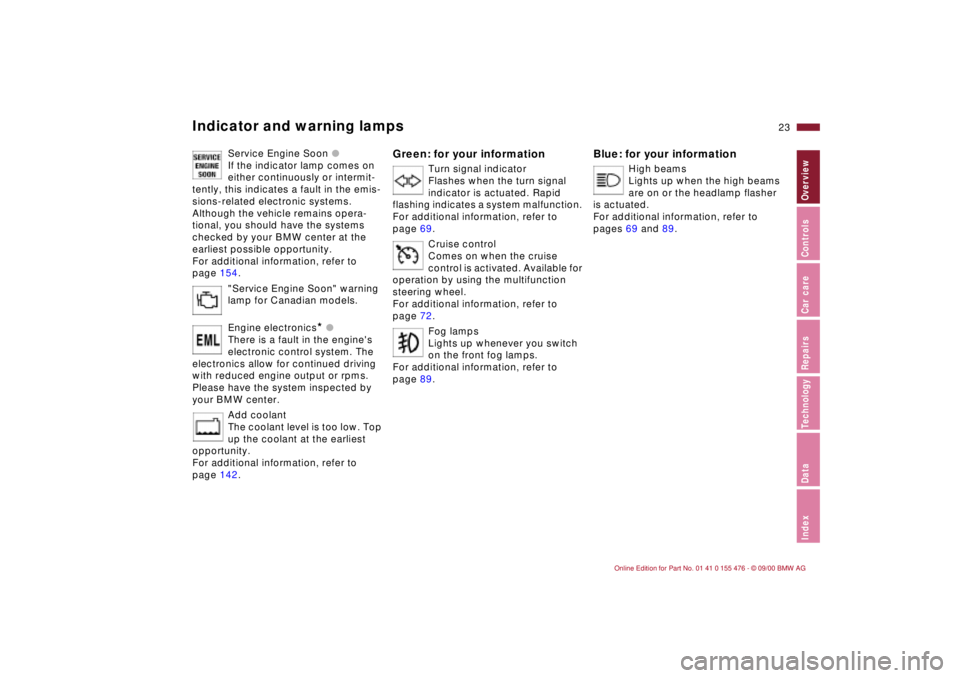
23n
IndexDataTechnologyRepairsCar careControlsOverview
Indicator and warning lamps
Service Engine Soon l
If the indicator lamp comes on
either continuously or intermit-
tently, this indicates a fault in the emis-
sions-related electronic systems.
Although the vehicle remains opera-
tional, you should have the systems
checked by your BMW center at the
earliest possible opportunity.
For additional information, refer to
page 154.
"Service Engine Soon" warning
lamp for Canadian models.
Engine electronics
* l
There is a fault in the engine's
electronic control system. The
electronics allow for continued driving
with reduced engine output or rpms.
Please have the system inspected by
your BMW center.
Add coolant
The coolant level is too low. Top
up the coolant at the earliest
opportunity.
For additional information, refer to
page 142.
Green: for your information
Turn signal indicator
Flashes when the turn signal
indicator is actuated. Rapid
flashing indicates a system malfunction.
For additional information, refer to
page 69.
Cruise control
Comes on when the cruise
control is activated. Available for
operation by using the multifunction
steering wheel.
For additional information, refer to
page 72.
Fog lamps
Lights up whenever you switch
on the front fog lamps.
For additional information, refer to
page 89.
Blue: for your information
High beams
Lights up when the high beams
are on or the headlamp flasher
is actuated.
For additional information, refer to
pages 69 and 89.
Page 26 of 211
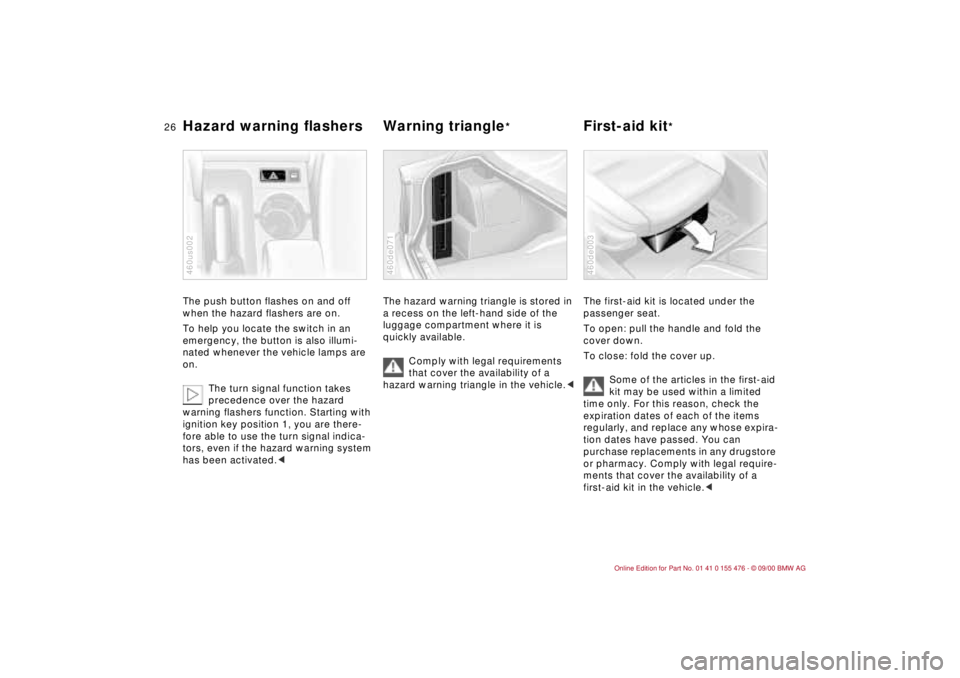
26n
Hazard warning flashers Warning triangle
*
First-aid kit
*
The push button flashes on and off
when the hazard flashers are on.
To help you locate the switch in an
emergency, the button is also illumi-
nated whenever the vehicle lamps are
on.
The turn signal function takes
precedence over the hazard
warning flashers function. Starting with
ignition key position 1, you are there-
fore able to use the turn signal indica-
tors, even if the hazard warning system
has been activated.<460us002
The hazard warning triangle is stored in
a recess on the left-hand side of the
luggage compartment where it is
quickly available.
Comply with legal requirements
that cover the availability of a
hazard warning triangle in the vehicle.<460de071
The first-aid kit is located under the
passenger seat.
To open: pull the handle and fold the
cover down.
To close: fold the cover up.
Some of the articles in the first-aid
kit may be used within a limited
time only. For this reason, check the
expiration dates of each of the items
regularly, and replace any whose expira-
tion dates have passed. You can
purchase replacements in any drugstore
or pharmacy. Comply with legal require-
ments that cover the availability of a
first-aid kit in the vehicle.< 460de003
Page 31 of 211
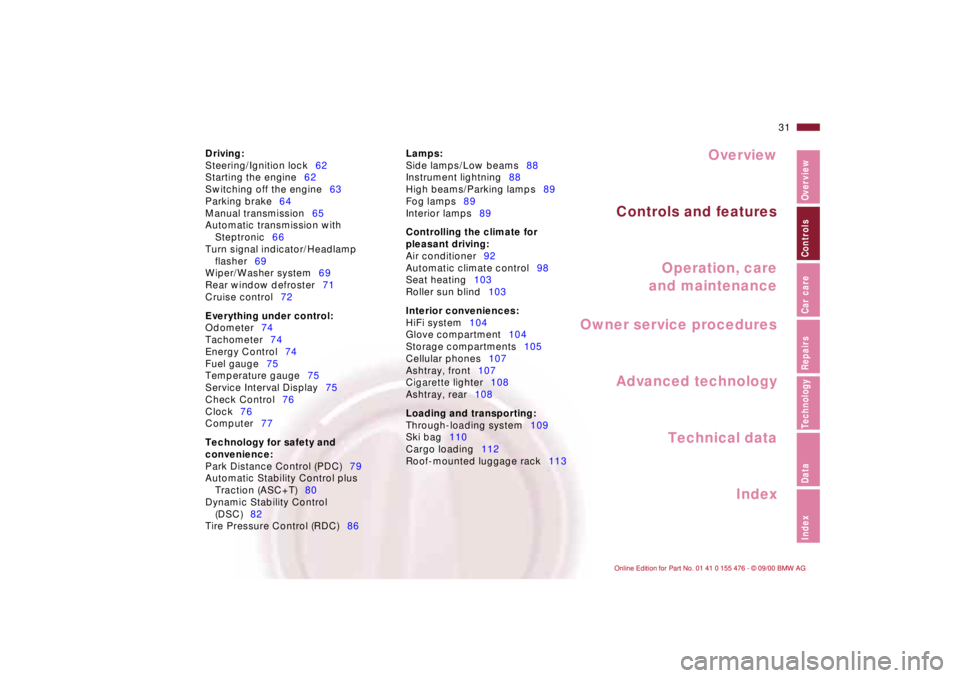
Overview
Controls and features
Operation, care
and maintenance
Owner service procedures
Technical data
Index Advanced technology
31n
IndexDataTechnologyRepairsCar careControlsOverview
Driving:
Steering/Ignition lock62
Starting the engine62
Switching off the engine63
Parking brake64
Manual transmission65
Automatic transmission with
Steptronic66
Turn signal indicator/Headlamp
flasher69
Wiper/Washer system69
Rear window defroster71
Cruise control72
Everything under control:
Odometer74
Tachometer74
Energy Control74
Fuel gauge75
Temperature gauge75
Service Interval Display75
Check Control76
Clock76
Computer77
Technology for safety and
convenience:
Park Distance Control (PDC)79
Automatic Stability Control plus
Traction (ASC+T)80
Dynamic Stability Control
(DSC)82
Tire Pressure Control (RDC)86Lamps:
Side lamps/Low beams88
Instrument lightning88
High beams/Parking lamps89
Fog lamps89
Interior lamps89
Controlling the climate for
pleasant driving:
Air conditioner92
Automatic climate control98
Seat heating103
Roller sun blind103
Interior conveniences:
HiFi system104
Glove compartment104
Storage compartments105
Cellular phones107
Ashtray, front107
Cigarette lighter108
Ashtray, rear108
Loading and transporting:
Through-loading system109
Ski bag110
Cargo loading112
Roof-mounted luggage rack113
Page 62 of 211

62n
0 Steering lock engaged The key can only be inserted or
removed in this position.
After removing the key, turn the
steering wheel slightly to the left or right
until the lock engages.
If the key is not removed, an acoustic
signal is sounded after the driver's door
has been opened.
Vehicles with automatic transmis-
sion:
Do not move the selector lever from the
"Park" position until the engine is
running (ignition key at position 2).
In order to turn the key back to posi-
tion 0 or to remove it, move the selector
lever into position "Park" first (Inter-
lock).<460de022
1 Steering lock disengaged Turning the steering wheel slightly to
the right or left often makes it easier to
turn the key from 0 to 1.
Individual electrical devices are ready
for operation.2 Ignition onAll electrical equipment and accesso-
ries are available for use.3 Starting the engine
Vehicles with manual transmis-
sion: depress the clutch when
starting the vehicle. A lockout prevents
the engine from starting if the clutch is
not depressed.c
Before starting>Engage the parking brake
>Be sure that the shift lever is in
"Neutral" or "Park" if the vehicle is
equipped with an automatic transmis-
sion
>Depress the clutch pedal.
Do not run the engine in enclosed
areas. The exhaust gases contain
carbon monoxide, an odorless and
colorless, but highly toxic gas.
Breathing the exhaust gases poses an
extreme health risk, and can lead to
unconsciousness and death.
Do not leave the vehicle unattended
with the engine running. An unat-
tended vehicle with a running engine
represents a potential safety hazard.<
Steering/Ignition lock Starting the engine